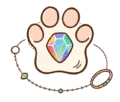Losing a loved one—whether a human family member or a cherished pet—leaves a void that’s hard to fill. In recent years, turning cremated ashes or a lock of hair into a physical memorial has become a meaningful way to honor their memory. Among the most popular options are diamonds and crystals, each offering a unique way to keep your loved one close. But how do they differ? This guide breaks down the key distinctions, helping you choose a tribute that aligns with your budget, values, and vision.
Appearance: Sparkle vs. Organic Charm


Manufacturing: High – Tech Precision vs. Accessible Craft
How DNA Diamonds Are Made?
Creating a diamond from ashes or hair is a feat of modern science, mirroring the natural process that forms diamonds deep in the Earth:
- Carbon Extraction: For hair, organic material is converted into pure carbon gas using hydrogen plasma, then purified to remove impurities. For ashes, carbon is isolated from mineral residues—a challenging task, as cremation reduces carbon content to just 0.5–4%.
- Synthesis: Using microwave plasma chemical vapor deposition (MPCVD) or high – pressure, high – temperature (HPHT) machines, pure carbon is subjected to extreme conditions (up to 2000°F and 800,000 psi) to replicate the Earth’s mantle, where diamonds form naturally.
- Cutting & Polishing: Skilled artisans cut and polish the rough diamond to maximize its sparkle, using tools designed for natural diamonds.
This process demands specialized equipment, strict quality control, and expert labor—all of which drive up complexity.
How Life Crystals Are Made?
Crystal production is simpler and more accessible. The ashes or hair are mixed with a base material, such as glass or mineral compounds. The mixture is then heated until it melts and is poured into a mold. During the cooling process, it solidifies into a crystal – like form. Optional colorants or small mementos can be added for personalization. No advanced technology is required, making the process faster (typically 2–4 weeks) and easier to scale.
Cost: Luxury Investment vs. Affordable Tribute
DNA Diamonds
Diamonds are a high – end investment. A 1 – carat diamond made from ashes or hair costs $10,000–$20,000, and larger sizes can exceed $30,000. Why so pricey?
- Equipment: HPHT and MPCVD machines cost hundreds of thousands of dollars.
- Labor: Carbon extraction and diamond cutting require specialized expertise.
- Time: The synthesis process takes 6–10 weeks, increasing production costs.
Life Crystals
Crystals are budget – friendly, ranging from $300–$1000. Their affordability stems from:
- Materials: Glass and mineral compounds are inexpensive compared to diamond synthesis supplies.
- Process: No costly machinery or expert labor is needed.
- Speed: Faster production reduces overhead, passing savings to customers.
Symbolism: Prestige vs. Natural Connection
What Diamonds Represent
Diamonds symbolize luxury, permanence, and “eternal love.” They appeal to those who want a prestigious, heirloom – worthy tribute—something that feels “valuable” in a traditional sense. For some, the diamond’s hardness mirrors the strength of their bond with the deceased.
What Crystals Represent
Crystals align with nature, spirituality, and the cycle of life. They symbolize a gentle, organic connection to your loved one, emphasizing that while their physical form has changed, their essence remains. Many find comfort in their natural imperfections, which mirror the uniqueness of the person or pet they honor.
Customization: Limited vs. Limitless
Diamonds
Customization is restricted to:
- Cut: Round, princess, or cushion shapes.
- Setting: Mounting in rings, pendants, or bracelets.
- Carat Size: Larger diamonds cost more but offer no unique design tweaks.
heir crystalline structure leaves little room for personal touches beyond jewelry aesthetics.
Crystals
Crystals are a blank canvas for creativity:
- Shapes: Hearts, stars, paw prints, or even replicas of a favorite object (e.g., a guitar pick).
- Colors: Match a loved one’s favorite shade or a meaningful hue (e.g., blue for calm).
- Inclusions: Embed a strand of hair, a small flower petal, or a hand – written note fragment.
- Engravings: Add names, dates, or a short message on the surface.
Why Choose Life Crystals?
For most people, crystals offer the perfect balance of meaning, accessibility, and personalization. Here’s why they stand out:
- Affordable for All: No need to overspend to honor your loved one—crystals make meaningful memorials accessible, regardless of budget.
- Truly Unique: Each crystal’s natural patterns and custom touches ensure it’s one – of – a – kind, just like the person or pet it represents.
- Flexible & Personal: From shape to color to embedded mementos, you can craft a tribute that tells their story.
- Gentle Symbolism: They embrace the beauty of imperfection and the natural cycle of life, offering comfort without pretense.
Final Thoughts
DNA diamonds are stunning, but they’re a luxury for a select few. Crystals, on the other hand, deliver heart and meaning at a price that works for most, with endless ways to make them your own. Whether you’re honoring a pet, a parent, or a friend, a crystal isn’t just a keepsake—it’s a tangible reminder that love outlives loss.
Keywords: ashes hair diamonds, ashes hair crystals, pet memorial keepsakes, human ashes memorial, memorial crystals vs diamonds, affordable pet tributes, unique ash memorials, personalized hair keepsakes, Losing a loved one—whether a human family member or a cherished pet—leaves a void that’s hard to fill. In recent years, turning cremated ashes or a lock of hair into a physical memorial has become a meaningful way to honor their memory. Among the most popular options are diamonds and crystals, each offering a unique way to keep your loved one close. But how do they differ? This guide breaks down the key distinctions, helping you choose a tribute that aligns with your budget, values, and vision.
